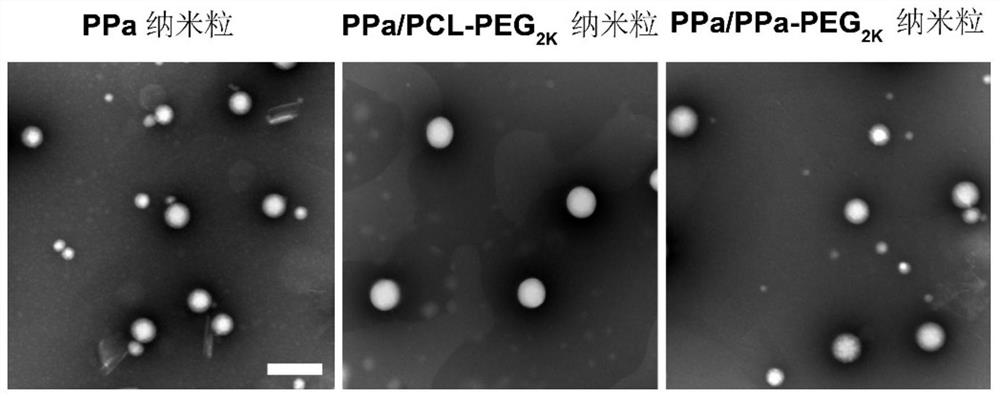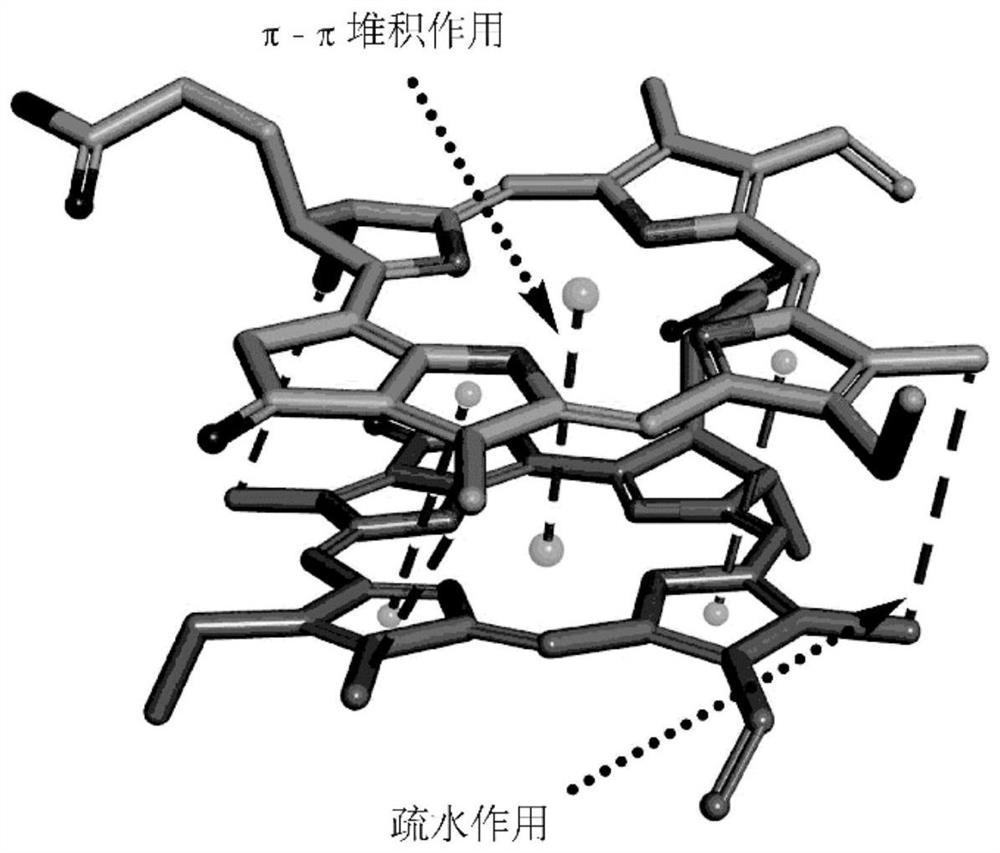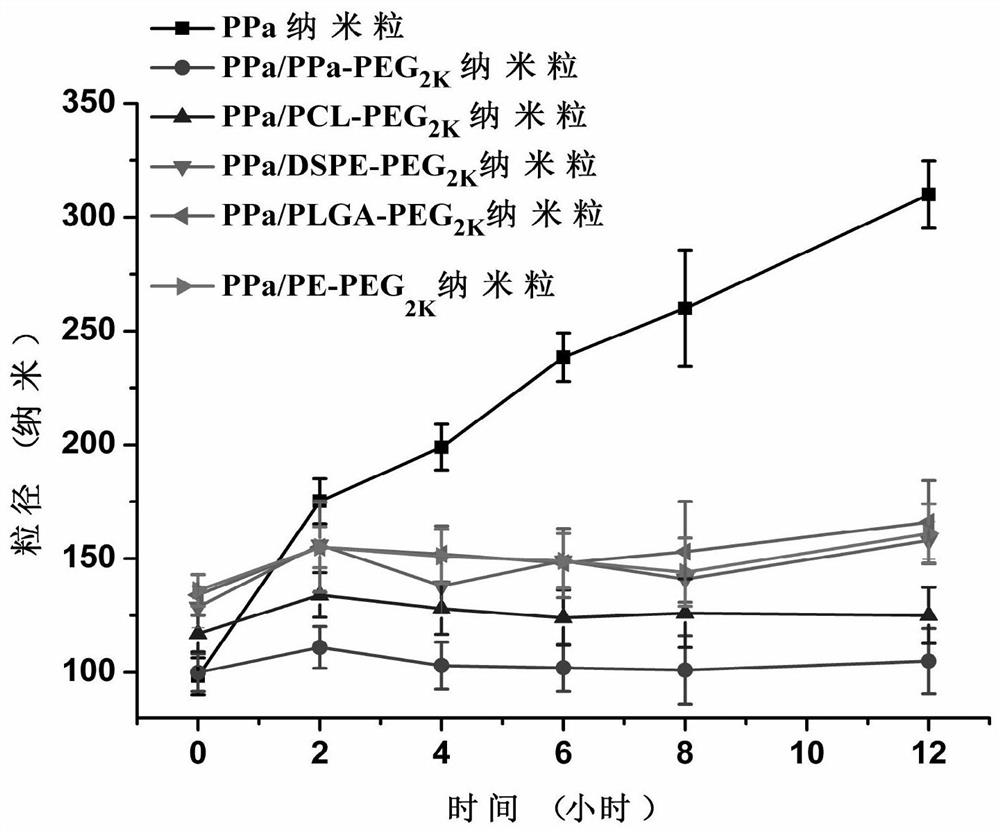Pure photosensitizer self-assembled nanoparticles and preparation and application thereof
A self-assembled nanoparticle and photosensitizer technology, applied in nanotechnology, nanotechnology, nanomedicine, etc., can solve the problems of drug leakage, poor PPa hydrophobicity, poor toxicity related to excipients, etc., and achieve high-efficiency encapsulation, good stability, Simple and easy preparation method
- Summary
- Abstract
- Description
- Claims
- Application Information
AI Technical Summary
Benefits of technology
Problems solved by technology
Method used
Image
Examples
Embodiment 1
[0043] Embodiment 1: Preparation of PPa self-assembled nanoparticles and PEG-modified PPa self-assembled nanoparticles
[0044] Accurately weigh 1 mg of PPa, dissolve it with 200 μL of a mixed solution of ethanol and tetrahydrofuran (3:2), and slowly add the solution dropwise to 2 mL of deionized water under stirring, to spontaneously form uniform nanoparticles of PPa nanoparticles. The organic solvent in the nano-preparation was removed by dialysis with deionized water at 25°C.
[0045] (1) The preparation method of non-PEGylated PPa self-assembled nanoparticles: Dissolve a certain amount of PPa in an appropriate amount of ethanol and tetrahydrofuran (3:2), and slowly add the solution dropwise to water under stirring, and the PPa spontaneously Form uniform nanoparticles. Ethanol and tetrahydrofuran in the preparation are removed by dialysis to obtain a nano colloid solution without any organic solvent.
[0046] (2) The preparation method of PEG-modified PPa self-assembled n...
Embodiment 2
[0055] Embodiment 2: The self-assembly mechanism analysis of PPa
[0056] Through simple computer simulations, the mechanism of PPa self-assembly was explored, and the molecular docking calculation was completed using the Vina program of the Yinfu cloud computing platform. The compound PPa was energy minimized under the MMFF94 force field to obtain a 3D structure and form a stable nanoassembly. AutoDock Vina program was used for semi-flexible docking, the results are as follows figure 2 As shown, the unique multiple pyrrole ring structures of PPa molecules, as well as the intermolecular π-π stacking and hydrophobic interactions have made great contributions to the self-assembly of PPa molecules.
Embodiment 3
[0057] Embodiment 3: Colloidal stability test of PPa self-assembled nanoparticle
[0058] 1 mL of the PEG-modified self-assembled nanoparticles prepared in Example 1 was taken out, added to 20 mL of phosphate buffered saline (PBS, pH 7.4) containing 10% FBS, incubated at 37° C. for 24 hours, and At predetermined time points (0, 1, 2, 4, 6, 8 and 12 hours), the particle size change was measured by dynamic light scattering. The result is as image 3 As shown, compared with other groups, PPa / PCL-PEG 2K Nanoparticles and PPa / PPa-PEG 2K The nanoparticle colloid has good stability, and the particle size does not change significantly within 24 hours. Further preferred is Pa / PCL-PEG 2K Nanoparticles and PPa / PPa-PEG 2K nanoparticles.
[0059] 1 mL of the PEG-modified self-assembled nanoparticles prepared in Example 1 was taken out and added to 20 mL of PBS. Under different laser irradiation times, the changes in the particle size of the nanoparticles were observed, and the result...
PUM
| Property | Measurement | Unit |
|---|---|---|
| Particle size | aaaaa | aaaaa |
| Particle size | aaaaa | aaaaa |
Abstract
Description
Claims
Application Information
 Login to View More
Login to View More - R&D
- Intellectual Property
- Life Sciences
- Materials
- Tech Scout
- Unparalleled Data Quality
- Higher Quality Content
- 60% Fewer Hallucinations
Browse by: Latest US Patents, China's latest patents, Technical Efficacy Thesaurus, Application Domain, Technology Topic, Popular Technical Reports.
© 2025 PatSnap. All rights reserved.Legal|Privacy policy|Modern Slavery Act Transparency Statement|Sitemap|About US| Contact US: help@patsnap.com



